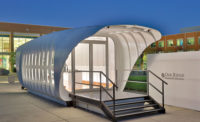If you walked by 12th and Vine in Philadelphia only two years ago, you’d never guess that the meager empty space on the corner could actually be a building site. In fact, the 93-foot-long lot was so improbably narrow—only 11 feet wide—that you’d probably miss it altogether. But now the sliver of land at the edge of the Center City district has been transformed by local architecture firm ISA into seven sleek and livable apartments. The oddly shaped lot is a leftover from the construction of Interstate 676, a below-grade multilane highway dating from the late 1950s that sliced through Philadelphia’s dense urban fabric.
Additional Content:
Jump to credits & specifications
Developer Callahan Ward acquired the site in 2015 for $265,000, and, through a series of deft moves, ISA was able to make the remnant workable. XS House contains a one-bedroom basement apartment, four “micro-lofts,” each with a sleeping mezzanine, and a pair of two-bedroom duplexes. The 72-foot-tall, primarily wood-framed structure (it also includes four steel moment frames), organized around a central stair, is classified by code as a four-story building.
Since the site had no height restrictions, the architects could theoretically have made XS House even taller, according to ISA principal Brian Phillips. However, the added height could only have been achieved with a series of tradeoffs which would have increased costs beyond the project’s $1.1 million construction budget and gobbled up valuable floor area. It would have required a steel or concrete structure, a second stair for egress, and, for practicality, an elevator. (The XS House ground-floor units are accessible.)
Even without such additional vertical circulation elements, the units are compact. The micro-lofts, for instance, are only about 500 square feet. However, the architects have made them feel roomy by creating nearly double-story living rooms (thanks to the inclusion of the sleeping mezzanines) and by employing such space-saving tactics as combining the kitchens and the entry foyers. They also took advantage of a city zoning provision permitting limited cantilevers over the lot line with 3-foot-deep, boxlike facade projections. These serve as bay windows, expanding the dimensions of the interiors, and as balconies. In addition, the protruding elements lend the long, main elevation a syncopated rhythm, providing a flair that enlivens its workaday fiber-cement siding.
The finishes inside, like the exterior cladding, are basic—including engineered-wood floors, painted drywall, and white lacquered cabinets. But along with generously sized windows that afford views of the surrounding cityscape, the mostly white and beige palette bolsters the sense of spaciousness. Accents of sunny yellow pop up here and there as well, animating such spaces as the shared central stair.
The project was conceived as housing for young professionals, with monthly rents starting at around $1,500, according to Nino Cutrufello, Callahan Ward’s development director. The building’s jazzy exterior, its airy interiors, and its location should make XS House a hit with these target tenants. But, for the time being, XS House is being leased to a company that rents out the apartments for short-term stays. The two bedrooms run at $99 per night. The developer plans for the units to be market-rate rentals in about two years, once its short-stay lease ends, he says.
Other cities are also looking at their irregular lots as one answer to the housing shortage. New York, for example, launched a design competition in 2019 to identify affordable multifamily concepts that could be implemented on small, leftover parcels. Even though XS House is a market-rate project, its inventiveness, spatial efficiency, and relative economy could make it a model—one that could provide solutions for other dense urban environments and for people within a wide range of income levels.
CreditsArchitect: ISA – Interface Studio Architects, 1400 N American St. #301, Philadelphia, PA 19122, 215-232-1500, www.is-architects.com
Personnel in architect's firm who should receive special credit: Brian Phillips, AIA, Leed AP, Deb Katz, AIA, Leed AP, Alex Gauzza, AIA, Leed AP BD+C, Matt Underwood, RA, Jason Jackson
Engineers: Structural: Larsen + Landis Structural Engineers MEP: J+M Engineering
Consultants: Lighting: Lam Partners
General contractor: Callahan Ward
Photographer: Sam Oberter |
SpecificationsStructural System Steel: Contrast Metal Works
Exterior Cladding Metal panels: Englert Inc Other cladding unique to this project: Fiber Cement Panels: James Hardie Reveal System
Roofing Other: TPO
Windows Fiberframe Frame: Anderson 100
Doors Entrances: Therma-Tru Smooth Star
Hardware Locksets: Schlage Pulls: Schlage
Interior Finishes Cabinetwork and custom woodwork: Multi-Housing Depot Solid surfacing: Quartz Floor and wall tile: Daltile Permatones Resilient flooring: Shaw Succession II Carpet: Mohawk Fiber Art Special interior finishes unique to this project: Wood laminate flooring: Mohawk
Lighting Interior ambient lighting: Klus LED strip, Bartco Downlights: Philips, Viso Exterior: Klus LED strip
Plumbing Bathroom Sink / Faucet: IKEA Toilet: Sterling Shower Controls: Moen Align Kitchen Faucet: IKEA Kitchen Sink: Sterling
Energy Washer/Dryer Combo: LG Dishwasher: Whirlpool Range: Maytag Microwave: Whirlpool Refrigerator: Whirlpool |










Post a comment to this article
Report Abusive Comment